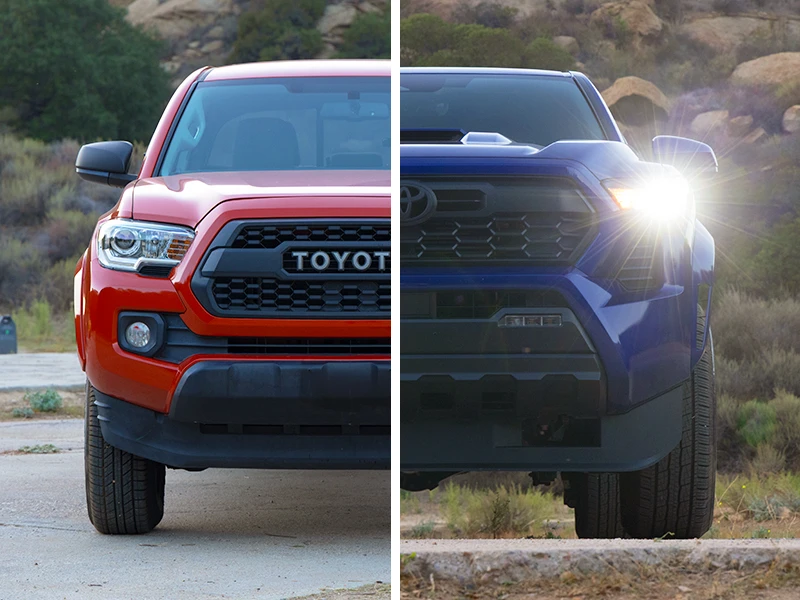
Costs, emissions, driving, and convenience–everything you need to know.
With thousands of vehicles in our inventory, we’re here to help make car research easier for you. We’ve partnered with car review experts from Edmunds to weigh in on what matters most when you’re looking to buy a truck or car.
***
Electric vehicles (EVs) offer a lot of advantages over gas cars, from lower running costs to lower lifetime emissions. But gasoline-powered cars currently have better infrastructure and are more familiar to most drivers. This article will cover important differences between electric and gas cars to help you understand the advantages and disadvantages of each. Whether you’re shopping for a car and trying to decide between gas and electric, or just want to learn more about EVs, we’re here to help.
Curious what a hybrid is and where it might fit in? Check out this article comparing plug-in hybrids, standard hybrids, and electric vehicles.
Electric car vs. gas car costs
The price you pay for a vehicle can vary wildly depending on its brand, features, size, condition, age, and mileage, so it can be difficult to compare upfront costs for gas and electric cars. That said, when comparing similar gas cars and EVs, electric cars generally have a higher upfront cost. Even so, a Consumer Reports study found that an average EV owner saves between $6,000 and $10,000 over the life of the vehicle.
If electric cars can cost more to purchase up front, why are they cheaper to own in the long run?
Electric vs. gas car fuel costs
The simple fact is that the average cost of charging an electric car is less than the average cost of fueling a gasoline car. A study by the Department of Energy showed that over the course of 15 years, EV owners could save as much as $14,500 on fuel costs compared to owners of gasoline cars. That’s a potentially massive saving for EV owners.
Obviously, where you live, what car you buy, and even how you charge can impact your fuel costs. Check out our full article on the cost of charging an electric car compared to pumping gas to learn more.
Electric car vs. gas car maintenance costs
Electric cars also have lower regular maintenance costs than gas cars because they’re mechanically simpler. With fewer moving parts and no need for oil changes–among other advantages–the federal Office of Energy Efficiency and Renewable Energy found that EVs cost 4 cents less per mile to maintain than gas cars. Over 15 years, that means the average American driver would spend about $8,000 less on maintenance.
Keep in mind, your vehicle choice and driving habits can impact your maintenance costs. High-mileage EVs may also require a battery replacement, while high-mileage gas cars can require more extensive mechanical repairs, which adds some uncertainty. For a full rundown, head to our full article on electric car maintenance costs

Government incentives and rebates
Programs offering tax incentives and rebates are designed to promote EV adoption and soften the upfront cost for buyers. The most well-known program is the federal tax credit of up to $7,500 for new electric cars and up to $4,000 for used electric cars. However, other programs exist at the state and local levels; your utility company may even offer a rebate on a new or used EV or on the installation of a charging station at your home.
It’s important to do your research into what incentives are available to you when considering the overall cost of an electric car. Edmunds has a complete rundown of the new federal tax credit and a list of other resources that can help you understand your options.
Electric car vs. gas car emissions
Electric cars generate zero tailpipe emissions, but that’s not the only way a car creates greenhouse gasses and other pollution.
Electric car vs. gas car carbon emissions
You may have heard that electric cars create more greenhouse gas pollution during manufacturing than gasoline cars, and in some parts of the country electricity is still generated by burning coal or natural gas. So why is transitioning to electric vehicles part of the effort to curb carbon emissions?
Electric vehicles use energy much more efficiently than gasoline-powered cars. Much of the energy in gasoline is lost as waste heat, or to friction in the powertrain. According to the EPA, EVs turn about 77% of the energy they take from the grid into power, while gasoline cars only turn about 12%-30% of the energy in gasoline into power. That means that even when powered with dirty energy—such as from coal and natural gas—electric cars are still responsible for fewer carbon emissions than gas cars. But renewable energy production continues to grow nationally, reducing carbon emissions overall.
Your electric car’s carbon footprint will vary depending on where you live and where your energy comes from. On average, though, the annual emissions from a gas vehicle are four and a half times greater than the emissions from an EV, according to data from the federal Alternative Fuels Data Center at the time of writing.
That efficiency helps EVs make up for the greenhouse gas emissions from their manufacturing. It’s true that the manufacturing of electric cars currently produces more carbon dioxide than manufacturing gas cars, mostly due to the resources required to produce large battery packs. Once on the road, it takes about 15,000 to 20,000 miles of driving for a typical EV to make up for those extra emissions, according to a study by Reuters. That’s less than two years of driving for the average American.
With the average age of a car on American roads a little over 12 years, electric cars are certain to produce fewer carbon emissions over their lifetimes than gasoline vehicles.
Electric car health and environmental benefits
Burning gasoline produces a number of other pollutants, many of which have a negative impact on human health and not just the environment. Exposure to pollution from car exhaust affects your lungs, heart, brain, and other organs. Asthma is one such health concern, and a study by the University of Southern California found that as EV adoption increased in a given ZIP code, there was a drop in both local air pollution and asthma-related emergency room visits.
Burning gasoline produces a number of other pollutants, many of which have a negative impact on human health and not just the environment. Exposure to pollution from car exhaust affects your lungs, heart, brain, and other organs. Asthma is one such health concern, and a study by the University of Southern California found that as EV adoption increased in a given ZIP code, there was a drop in both local air pollution and asthma-related emergency room visits.
Beyond air pollution, electric cars can help reduce pollution in other ways. For example, motor oil contains toxic chemicals and chemicals known to cause cancer. Oil that leaks from cars or is disposed of improperly can contaminate local aquifers and groundwater supplies. The EPA estimates that 200 million gallons of oil are improperly disposed of in the U.S. each year. Eliminating the need for motor oil contributes to electric cars' environmental benefits.
Driving electric cars vs. gas cars

There are a few key differences in the way gas and electric cars drive, with EVs offering smoother power delivery and some unique driving options.
Torque and acceleration
Because of the way in which electric motors work, they’re capable of delivering their full torque immediately, while gasoline engines need to rev up first. In electric cars, that’s referred to as “instant torque,” and it means electric cars feel quicker when pulling away from a stop or trying to pass on the freeway.
Electric cars also don’t generally use multi-speed transmissions like gasoline cars, so they don’t need to change gears while accelerating or when you ask for more power. That reduces response time, improves acceleration, and makes driving feel smoother.
Some of the quickest-accelerating cars in the world right now are high-performance EVs, but even mainstream electric cars tend to feel quick and smooth on the road.
One-pedal driving and regenerative braking
Most electric cars offer a driving mode known as “one-pedal driving,” which turns the accelerator pedal into something a bit more like a speed selector. In typical driving, when you lift your foot off the accelerator the car will coast, but in one-pedal mode the car will slow down as you lift your foot.
Electric cars use regenerative braking, where the electric motors slow the car down while also acting like generators to recapture electricity to charge the battery a little bit. This adds to the efficiency of EVs, and the braking effect can feel quite strong. In many EVs it can bring you to a complete stop. Even when you use the brake pedal in an EV, it generally engages regenerative braking first and then the physical brakes if you need more stopping power. One-pedal driving means that if the electric motors aren’t accelerating or holding a steady speed, they’re braking, creating the slowing effect.
You can still use the brake pedal for more stopping power while in one-pedal mode, but the advantage of this mode is that it encourages smoother driving and lets you know that you’re recapturing the most possible energy.
Electric car vs. gas car convenience and flexibility
In some ways, electric cars can be very convenient, but the more developed gas infrastructure and some advantages when it comes to towing mean gas-powered vehicles are currently more flexible.
Range anxiety and charging times
For everyday driving and commuting, most EVs offer more range than the average driver needs. And if you’re able to charge up at home or at the office, you should be able to always keep enough range available. The trick to beating range anxiety is to think about how much you drive in a day, and keep in mind that—if you can charge at home overnight—you’ll start each morning with your car’s full range available to you. For more help, check out our guide to figuring out how much electric car range you really need.
Fortunately, there are plenty of apps and websites that can help you find fast chargers and plan your route for longer trips. Still, with current charge times and infrastructure restraints, electric cars don’t have the same kind of go-anywhere-anytime flexibility as gas cars.
Gas cars are supported by a well-developed network of more than 100,000 gas stations across the country, and we know that if we have to stop for gas it’ll only take us a few minutes. Even the fastest-charging electric cars need 15 to 20 minutes to give you equivalent charge to a fillup. Those charging speeds are only available with Level 3 or DC fast chargers, and even then, only on Level 3 chargers capable of charging at 350 kilowatts. If you’re taking a long journey, an EV not only adds time to your stops, it adds potential confusion as you need to plan out your stops to ensure the right kind of chargers are available. You can learn more from our guide to EV charging.
Frunks and cargo space

It’s common for electric cars to package their batteries as basically large, flat “skateboards” that go under the floor of the vehicle. Additionally, electric motors require less space than gas engines, and EVs don’t need to find a place to put a large multi-speed transmission. That means electric cars can be designed to offer excellent interior space and cargo space for their size.
Without gas engines taking up space under the hood, some electric cars offer an additional storage compartment called a frunk. Frunk is a combination of “front” and “trunk,” referring to an additional cargo space under the hood of a vehicle. These can range from tiny cubbies that are mostly only useful for storing backup charging cables to massive spaces that rival the trunks found in compact sedans.
While there used to be a number of rear-engine coupes and sedans, like the old Volkswagen Beetle, these days that layout is very rare since most cars have their engine in front. Right now, the Porsche 911 is the most common gas car you’re likely to find with a frunk.
Electric truck towing
Gas and diesel engines are great for towing anything from small trailers to big campers or even boats. Once they’re at speed, gasoline engines don’t have to work as hard to maintain speed. Adding the weight of a trailer to a powerful truck can impact its acceleration and braking but doesn’t really impact its ability to cruise comfortably.
Electric motors work harder at maintaining vehicle speed, and adding more weight and aerodynamic drag increases their load. While their ability to generate strong instantaneous torque means they’re very capable of moving heavy loads, their range can be significantly impacted. In an Edmunds real-world test, we saw the projected range on two electric trucks drop to less than half their normal range.
So while electric trucks do a great job accelerating and passing other vehicles, even with heavy loads, they’ll require more frequent charging when towing.
Over-the-air updates
Over-the-air updates (or OTA updates, sometimes referred to as OTAs) are updates to computer systems in a car that are downloaded wirelessly, either over a cellular or Wi-Fi connection. Both gas and electric cars can receive OTA updates, but the deep integration of computer systems in EVs means OTAs can have a more significant impact.
It’s not uncommon for modern gas-powered cars to receive OTA updates for their infotainment systems, which can do things like refine the user interface or even activate features with preexisting hardware support, like wireless Apple CarPlay® or Android Auto™. A few gas cars even have driver aids that can be adjusted by over-the-air updates.
Some EVs receive more comprehensive updates, including changes to how they respond to throttle and brake inputs, how their battery management software works, and more. The result is that electric car OTAs can adjust how a car feels on the road and even how much range is available.
The idea is that over-the-air updates can help keep a car feeling fresh longer and potentially address some issues without requiring a service visit.
Other considerations for shoppers
Most current electric vehicle models are two-row SUVs, with only a handful of examples of other body styles available. That means very limited choices for popular body styles like three-row SUVs and trucks. More three-row SUVs and trucks are on their way from multiple manufacturers, but they’ll take some time to become common on the used market. For now, at least, gas cars offer more choices in terms of body styles and configurations.
Electric car technology is also evolving much faster than gas technology. A lot of industries—not just car manufacturers—are eager to find new ways to make batteries lighter, cheaper, and more efficient. We’ve already seen efficiency, charging times, and battery longevity improve in the last decade, and that trend is likely to continue. Now, many electric vehicles have a range of up to 500 miles. Still, some shoppers are putting off making the switch to electric, opting to wait and see if future EV technology lives up to its promises.
Edmunds says
Electric cars are cleaner, more efficient, and cheaper to operate than gas cars. But the need for more infrastructure, limited choice of body styles, and limitations on the go-anywhere-do-anything-anytime flexibility compared to gas cars mean they’re not right for every driver just yet.




